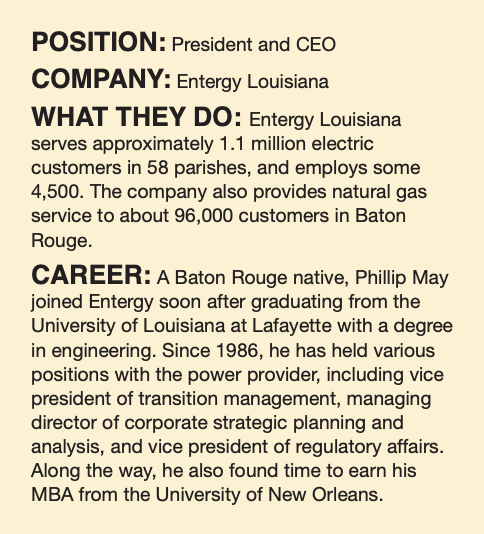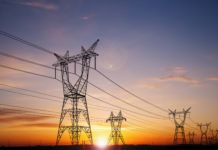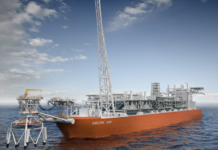Today, as president and CEO, May is responsible for the company’s safe and reliable service, financial performance, customer service, regulatory and public affairs, resource planning, economic development programs and charitable contributions. Under his leadership, Entergy Louisiana has constructed roughly 3,000 megawatts of modern, efficient generation units, as well as added solar and renewable energy resources. May is currently implementing the company’s long-term strategy to modernize its power generation fleet.

THE CHALLENGE
Without question, the task of restoring power in the wake of multiple catastrophic hurricanes in 2020-21 was an unprecedented challenge for Entergy. Hurricane Ida alone damaged a record-breaking 30,000 power poles.
After making landfall near Fourchon, Ida traveled northward, wreaking devastation in countless communities along the way and significantly impacting the New Orleans and Baton Rouge metro areas. “There were nearly 1 million customers without power,” May says. “Because of its path, Ida affected a very large number of customers.”
And when some 26,000 electrical workers from 41 states arrived to provide much-needed help, it created a particularly unique challenge, considering that COVID-19 pandemic safety protocols had to be followed. “We had to find ways to house and feed those people,” May says, “and we could only have one person per hotel room. As an alternative, we set up tents and created base camps.”
Then there were the inherent supply chain issues. “Just procuring the power poles was a Herculean effort,” he adds. “In many cases, we had production running around the clock for pole production. Every time one came off the assembly line, they were loaded onto a truck and taken to a location.”
May compares the experience to managing a small army. “Frankly, we’ve done it all before, but it’s the scale of the effort and the fact that it happened during a pandemic that made it particularly problematic.”
THE RESOLUTION
Over the years, Entergy has become amazingly efficient at managing large groups of people across broad swaths of territory. But this time was different. “We get better after each one of these things, but managing 26,000 people was a heroic event,” May says.
A typical crew would wake up in the morning, eat breakfast, work 16 hours, then come back for dinner and rest. Then an entirely different team would get busy doing laundry, making repairs, preparing plans and other tasks to ensure that work could continue the next day.
“Having someone go out and reset a pole—that’s the easy part,” May says. “The hard part is developing and executing the plan to make it happen. It’s a huge effort that involves lots of people with many different skillsets. Things happen: Engines fail, tires go flat, there are transmission problems etcetera, so you have to have mechanics on hand. And with that many people, you’ve got to get gas and diesel to everyone at a time when fuel is in short supply.”
Entergy measured its progress based upon its success in executing the plan. “Just three days after Ida made landfall, Sept. 1, we had the first lights come on in New Orleans,” May says. “That was an incredible milestone. By Sept. 3, about 25 percent of customers had power, then we achieved 90 percent by Sept. 13.”
THE TAKEAWAY
Hurricanes Laura and Ida provided irrefutable proof that hurricanes are increasing in both intensity and frequency along the Gulf Coast. That makes a stronger, more resilient power grid all the more important.
“The transmission lines that we replaced following Ida can now withstand winds of at least 150 mph,” May says. “We knew that putting in a more resilient system was going to take longer in places such as Grand Isle, so we used generators out there to allow us to provide power while we were making the repairs.”
The company also got creative by cutting some unused 36-inch oil pipeline into 16-foot sections to be used as foundation caissons for the power poles. “The new design calls for super-strong Class 1 timber poles with less wind resistance, supported by caissons, rock and aggregate to hold those poles in place.”
Beginning in April, Entergy will begin its storm preparations for the next hurricane season. “We always boost our inventory of material prior to a storm,” May says, “and this year we’re going to increase those numbers even more. But in the end, it’s all about having the plan, working the plan, and dealing with the various challenges that come along the way.
“And we have a very experienced and capable team for doing just that.”








